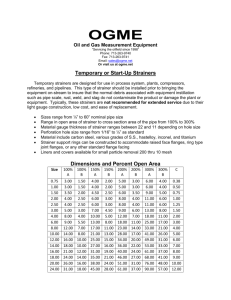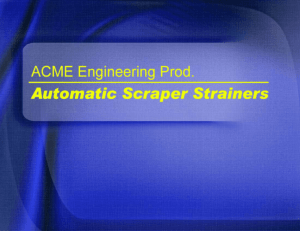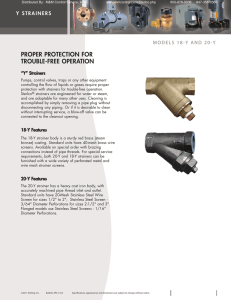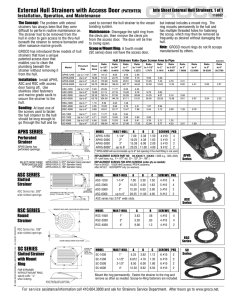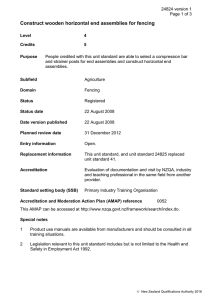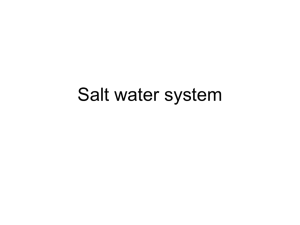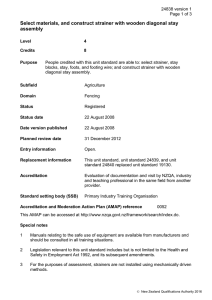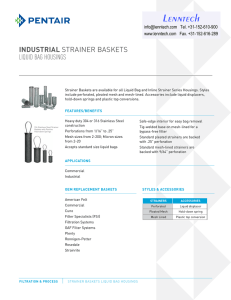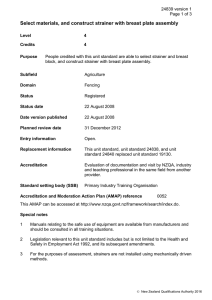Strainers, Inside and Out - Steve D`Antonio Marine Consulting
advertisement
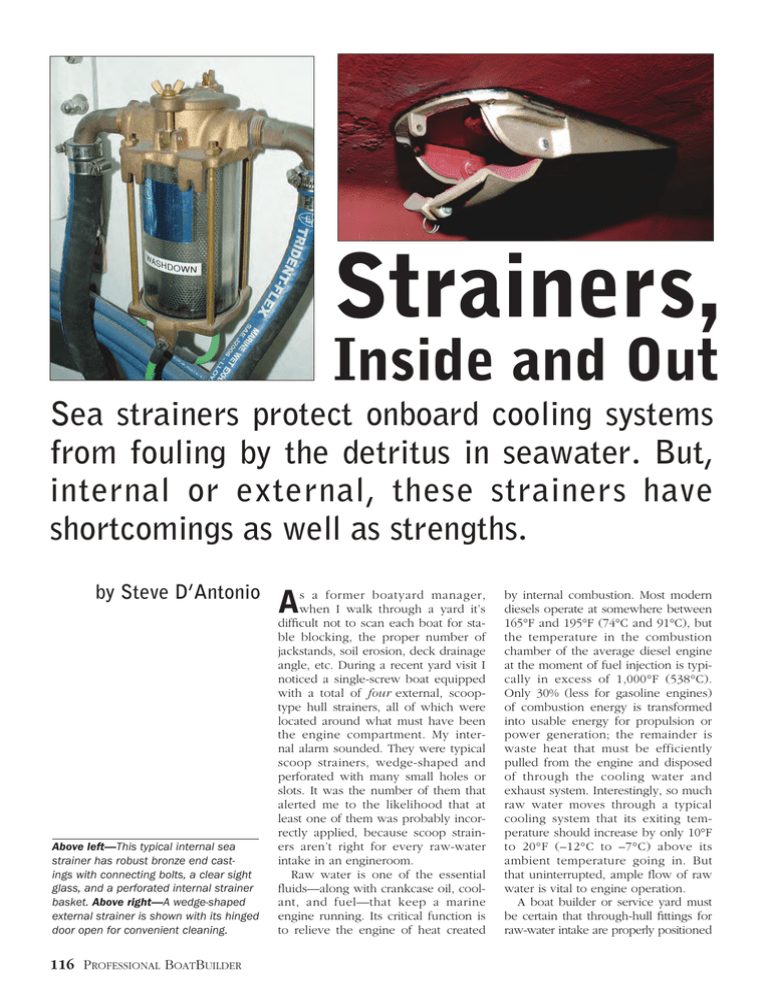
Strainers, Inside and Out Sea strainers protect onboard cooling systems from fouling by the detritus in seawater. But, internal or external, these strainers have shortcomings as well as strengths. by Steve D’Antonio Above left—This typical internal sea strainer has robust bronze end castings with connecting bolts, a clear sight glass, and a perforated internal strainer basket. Above right—A wedge-shaped external strainer is shown with its hinged door open for convenient cleaning. 116 Professional BoatBuilder A s a former boatyard manager, when I walk through a yard it’s difficult not to scan each boat for stable blocking, the proper number of jackstands, soil erosion, deck drainage angle, etc. During a recent yard visit I noticed a single-screw boat equipped with a total of four external, scooptype hull strainers, all of which were located around what must have been the engine compartment. My internal alarm sounded. They were typical scoop strainers, wedge-shaped and perforated with many small holes or slots. It was the number of them that alerted me to the likelihood that at least one of them was probably incorrectly applied, because scoop strainers aren’t right for every raw-water intake in an engineroom. Raw water is one of the essential fluids—along with crankcase oil, coolant, and fuel—that keep a marine engine running. Its critical function is to relieve the engine of heat created by internal combustion. Most modern diesels operate at somewhere between 165°F and 195°F (74°C and 91°C), but the temperature in the combustion chamber of the average diesel engine at the moment of fuel injection is typically in excess of 1,000°F (538°C). Only 30% (less for gasoline engines) of combustion energy is transformed into usable energy for propulsion or power generation; the remainder is waste heat that must be efficiently pulled from the engine and disposed of through the cooling water and exhaust system. Interestingly, so much raw water moves through a typical cooling system that its exiting temperature should increase by only 10°F to 20°F (–12°C to –7°C) above its ambient temperature going in. But that uninterrupted, ample flow of raw water is vital to engine operation. A boat builder or service yard must be certain that through-hull fittings for raw-water intake are properly positioned so they remain submerged at all times. If the intake is too far forward on a planing or semi-planing boat, it can ingest air rather than water, which could lead to overheating. If it’s too far outboard, rolling or a sailboat’s heel can expose the intake. Additionally, debris drawn into an open raw-water intake has the potential to limit flow and foul the pump or the heat exchanger, which will almost certainly lead to overheating. Most engine manufacturers suggest installing a raw-water strainer, either internal or external. Internal Strainers Internal strainers are most commonly cylindrical or pancake-shaped, the former being most popular. They are made of cast bronze with a clear plastic sight glass or lid, though I confess I have rarely been able to see through the sight glass to determine if it’s clogged. That’s because the debris in most strainers is contained within a removable perforated strainer basket at the core of the cylinder. You really need to open the top to see what’s inside the strainer basket. In the pancake variety of strainer it’s easier to view the contents without removing the lid. Some internal strainers are manufactured entirely of non-metallic components. My personal rule on raw-water plumbing components is: Whatever the material, if you can’t stand on it, it’s likely not strong enough for raw-water use. As I move around the engineering spaces of a A slotted scoop strainer keeps out the largest potentially damaging detritus (such as fishing gear and floating plastic) and sea life (such as kelp or jellyfish). It must be used in conjunction with a finer internal strainer for most applications. vessel, the last thing I want to be concerned about is stepping on a pipe or fitting that, if broken, will lead to flooding. In my opinion, the only non-metallic material that should be used for raw-water strainer bodies is glass-reinforced polymer, often known by the trade name Marelon, which is manufactured by Forespar Products (Santa Margarita, California). Whatever material you install, it’s easy to perform your own stand-on test… before the boat is put in the water, where it’s most vulnerable to damage if there’s a failure. The primary advantage of an internal raw-water strainer—whether it’s for an engine, generator, air conditioner, or any other raw-water-consuming device—is its ease of service. If it becomes clogged, you simply: shut the seacock, open the strainer lid (it’s handiest if tools aren’t required), remove the basket, dump out the contents (while watching out for jelly­ fish, crabs, eels, fishing gear, etc.), reinstall it, close the lid, open the seacock, check for water and air/vacuum leaks, and you’re on your way. It’s one of the four tasks every vessel owner/operator should be taught how to do (along with changing fuel filters, bleeding the fuel system, and replacing impellers). Arming your customers with these skills is well worth the effort. Someday they’ll thank you for it. External Strainers So why not keep the sea grass, kelp, and jellyfish out of the internal strainer basket so that it never clogs? This is where external models come in: straining raw water before it makes its way into the boat and engine. They are extremely popular in parts of the world where such fouling agents are common, and on unattended gear such as generators, air conditioners, and refrigeration systems. Unlike the internal strainer, there’s no basket to clear on a regular basis, because material the external strainer keeps out of the raw-water intake is free to drift away. An added advantage of the external hull strainer is ram effect; it will force water into an engine intake throughhull under pressure, which will almost certainly improve cooling system performance and extend impeller life. Most engine manufacturers specify an allowable vacuum—usually not more than 5" (127mm) of mercury—that can be tolerated by an engine’s rawwater pump. Many boats I inspect operate with raw-water intake vacuums far in excess of that figure. High vacuum shortens pump life, sometimes dramatically, and in extreme Far left—Even though most internal strainers are not this murky, you usually have to remove the lid to see what’s in the basket. Left—A more modern version affords a better view to easily assess fouling—without actually opening the strainer. October/November 2010 117 cases may cause the engine and/or exhaust system to overheat at higher rpm. In many cases, ram effect from a scoop strainer will lower the intake vacuum to meet the engine manufacturer’s requirements. There’s a downside to that characteristic of scoop strainers: Because the scoop is a passive device always attached to the hull, it drives water into the raw-water system it serves whenever the vessel is moving forward and even when it’s moored in a strong current, regardless of whether the system needs water at the time. The scoop may be pushing water into gear that’s not operating, such as a generator, a wing engine, a sailboat’s auxiliary, or a trailing inoperative engine on a twin-screw boat. Under ideal circumstances, the blades of the raw-water impeller prevent the water from being pushed into an idle engine. But if the blades are damaged, missing, or weak, raw water can push past the pump and ultimately into the exhaust system, where it can, depending upon the design, accumulate until The slight forward angle of this external strainer drives water into the attached system when the boat is under way, or moored in a strong current. This ram effect can help extend the life of raw-water impellers, but can also cause seawater to flood the cylinders of engines not in use while the boat is under way. 118 Professional BoatBuilder it reaches the exhaust manifold. Most exhaust risers and elbows are no match for such flood­ing. Remember, the water is under pressure, so it will push uphill above the waterline. Once water reaches the exhaust manifold, it will flow into any open exhaust valve in the cylinder head, and then into the cylinders. Seawater inside an engine’s cylin­d ers, with all those shiny, polished, dissimilar metal surfaces, is a disaster. If the water sits there, the piston rings will eventually fuse to the cylinder wall, effectively seizing the engine and causing untold damage. If you try to start the engine while water remains in the cylinders, the pistons will attempt to compress an incompressible medium, which almost always leads to serious damage in the form of bent connecting rods, cracked rings, shattered pistons, and more—a mechanical nightmare. Should you remove scoop strainers from all your customers’ boats? The answer is a qualified no, as long as you understand the side effects of the device and when and where it should and should not be applied. Left—Partially plugged by paint, the slotted scoop strainer is trapping material inside, and must be disassembled to clear it. Right—The holes in this round external strainer are hopelessly sealed with paint, which seriously compromising the operation of the raw-water system. In short, you can safely install external strainers on any equipment that allows water to be pumped into it without causing damage or flooding when it’s not operating: washdown pumps, hydraulic coolers, air conditioners, and refrigeration systems where pressure imparted by the scoop helps to maintain the prime of pumps that are notorious for losing it. Scoop strainers can serve propulsion engines, but there are limitations. If one engine of a twin-screw boat is not operational while the boat is under way, the scoop-equipped seacock for the idle engine must be closed. Likewise for boats under tow, scoop-equipped seacocks for engines and gensets must be closed for the duration. Scoopstrainer-equipped engine seacocks are inadvisable on sailboats, which are under way so much of the time without the engine running. Scoop strainers must never be installed on a generator unless the intake seacock is closed whenever the generator is not running and the vessel is under way—a requirement so impractical as to render it a non-option. External strainers are advantageous only until they become clogged with marine life or bottom paint. Then they become a flow-restricting detriment. October/November 2010 119 Ordinary external strainers must be removed (unscrewed) from the hull to be cleaned and painted. Preferable are models that can be disassembled or opened to allow periodic maintenance without complete removal. 120 Professional BoatBuilder machine screws. In theory, this arrangement is easily removable; in practice it’s difficult. When the boat is out of the water, the screws tend to break when removed. When the strainer is serviced under water, dropped screws sink out of sight. One variety of scoop strainer is equipped with a hinged trapdoor that’s easily opened with a wrench or socket, and in some cases by simply removing a pin held by These two external strainers can be easily a split ring—no tools required. cleaned of detritus that might otherwise make Instead of tiny, easily its way into the system. The round strainer with clogged straining holes, some the hinged trapdoor is designed to impart no ram models have long, wide slots, effect. but they must be used with an internal strainer whose basket will stop small debris that gets Nonremovable strainers that are part through the slots. (Note that some of the through-hull fitting should not engine manufacturers specify the size be installed; or if already present, of the holes on strainers, internal or replaced. Some strainers pull water external. Cummins, for instance, specthrough a flat plate perforated with ifies a maximum of 1⁄16" /1.6mm). Scoop strainers should never be dozens of small holes. The plate is installed facing aft. That orientation held to the body of the strainer with Filter-feeding barnacles have found a protected habitat in this hard-to-remove external strainer. By obstructing water flow, they pose a risk to the workings of the raw-water pump that the strainer is intended to protect. increases vacuum, puts additional stress on raw-water pumps, and in some circumstances prevents water from being pumped. If you must equip a generator or sailboat engine with an external strainer, it should be a round, omnidirectional model that imparts no ram effect. They are available in the desirable and easily serviced trapdoor style. Finally, because scoop strainers are subjected to considerable water friction while creating drag (in my experience, 1⁄4 knot is sacrificed for each full-size external scoop strainer installed), it’s important that they be properly secured to the hull. Fastening a strainer to a hull with self-tapping screws invites its loss, because the holes in the hull are enlarged every time a fastener is removed. Through-bolt scoop strainers to the hull with silicon-bronze fasteners. Stainless steel fasteners, most of which are made of 18-8/304 alloy, are susceptible to crevice corrosion, particularly in this application, where there is continuous contact with oxygen-depleted wet fiberglass laminate or wood planking. If the hull is a composite laminate, follow proper reefing and epoxy-backfilling core-closeout procedures. If your customer simply can’t go without external strainers because of waterborne detritus and marine life in his home waters, or the system installation requires ram effect to keep intake vacuum at an acceptable level (and the warranty valid), explain the limitations of the hardware and install it only where appropriate. About the Author: For many years a full-service yard manager, Steve now works with boat builders and owners and others in the industry as “Steve D’Antonio Marine Consulting.” He is a contributing editor of Professional BoatBuilder, and awaits publication (by McGraw-Hill/International Marine) of his book on marine systems. October/November 2010 121
